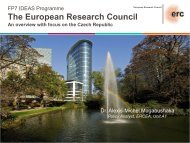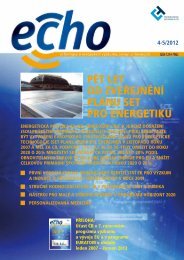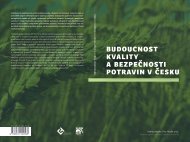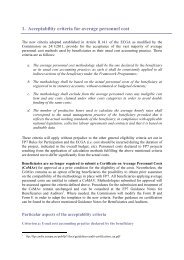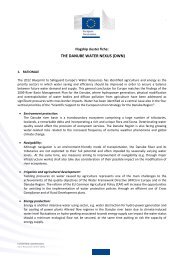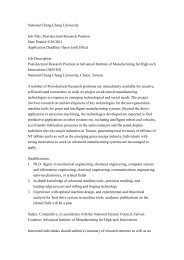Guide to Research and Innovation Strategies for Smart Specialisation
Guide to Research and Innovation Strategies for Smart Specialisation
Guide to Research and Innovation Strategies for Smart Specialisation
You also want an ePaper? Increase the reach of your titles
YUMPU automatically turns print PDFs into web optimized ePapers that Google loves.
Green growth<br />
Why should green growth be part of smart specialisation?<br />
In a resource-constrained planet, Europe needs <strong>to</strong> accelerate its transition <strong>to</strong>wards a climate<br />
resilient <strong>and</strong> greener economy <strong>to</strong> boost its competitiveness <strong>and</strong> be able <strong>to</strong> sustain its growth.<br />
This is why sustainable growth is one of the priorities of Europe 2020, which stresses the need<br />
<strong>for</strong> a transition <strong>to</strong> a green, low-carbon, resource efficient economy as a new paradigm <strong>for</strong><br />
sustainable growth. <strong>Innovation</strong> is essential <strong>to</strong> succeed in decoupling growth from natural<br />
capital utilisation <strong>and</strong> is there<strong>for</strong>e the key <strong>to</strong> enabling sustainable <strong>and</strong> smart growth <strong>to</strong> go h<strong>and</strong><br />
in h<strong>and</strong>. <strong>Innovation</strong> strategies <strong>for</strong> smart specialisation will need <strong>to</strong> foster green growth. This<br />
will result in an EU economy that is more competitive in a world of high energy prices <strong>and</strong><br />
<strong>to</strong>ugh resource constraints <strong>and</strong> competition. In this framework, public decision-makers <strong>and</strong><br />
stakeholders in Europe’s regions <strong>and</strong> cities, which are responsible <strong>to</strong> design, implement <strong>and</strong><br />
moni<strong>to</strong>r these strategies, play a crucial role.<br />
Not only do they often set the framework, but local <strong>and</strong> regional authorities are also usually<br />
responsible <strong>for</strong> implementing policies, programmes, legislation <strong>and</strong> public investments in key<br />
areas <strong>for</strong> sustainable growth <strong>and</strong> innovation such as energy, environment, transport, l<strong>and</strong>-use,<br />
education or social services. The coordination of different policies <strong>and</strong> different levels of<br />
government is always a challenge, but it is critical in accelerating the transition <strong>to</strong>wards a<br />
greener economy <strong>and</strong> getting the ac<strong>to</strong>rs of innovation <strong>and</strong> environment working <strong>to</strong>gether.<br />
Moreover, regions have <strong>to</strong> reflect on how <strong>to</strong> benefit from the fast emerging greening ecoinnovation<br />
sec<strong>to</strong>r.<br />
How <strong>to</strong> act?<br />
In the current programming period, ensuring innovation <strong>for</strong> sustainable growth requires<br />
improved coordination between different operational <strong>and</strong> rural development programmes in<br />
the areas of innovation, competitiveness, environment <strong>and</strong> energy; it requires integrated <strong>and</strong><br />
cross-cutting approaches that combine innovation <strong>and</strong> sustainability in<strong>to</strong> joint policies <strong>and</strong><br />
programmes.<br />
Managing authorities need <strong>to</strong> work <strong>to</strong>gether <strong>and</strong> also make sure <strong>to</strong> involve relevant ac<strong>to</strong>rs,<br />
such as environmental or energy agencies as well as NGOs <strong>and</strong> other representatives of civil<br />
society. Public <strong>and</strong> private sec<strong>to</strong>r decision makers need <strong>to</strong> integrate in<strong>to</strong> their day-<strong>to</strong>-day<br />
decision making process sustainable development principles; sustainability must be integrated<br />
throughout the strategies <strong>for</strong> growth <strong>and</strong> in the project life-cycle, taking in<strong>to</strong> account the<br />
impacts on the environment from design <strong>to</strong> delivery <strong>and</strong> end of life.<br />
As part of their innovation strategies <strong>for</strong> smart specialisation, public authorities at regional<br />
<strong>and</strong> local level also need <strong>to</strong> design interventions that help <strong>to</strong> overcome specific market failures<br />
in this area, as well as improving the supply of green innovation, technologies <strong>and</strong> solutions.<br />
Among the core measures that should be encouraged are:<br />
• Commissioning a strategic analysis <strong>and</strong> approach on the region's own characteristics,<br />
assets, challenges <strong>and</strong> opportunities as regards its environment, natural assets, renewable<br />
104



